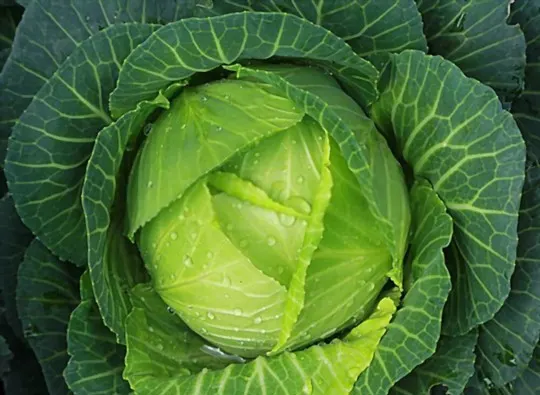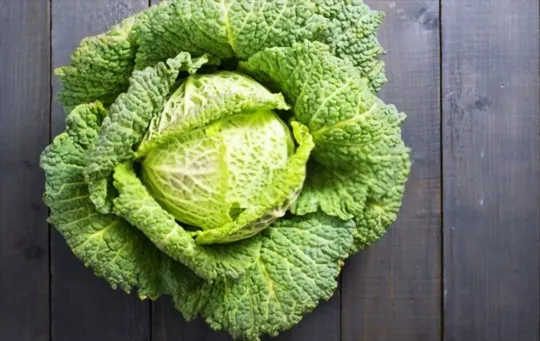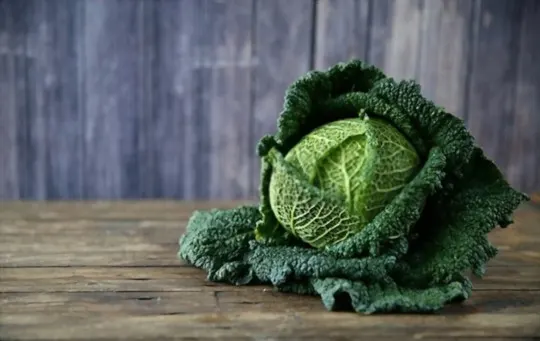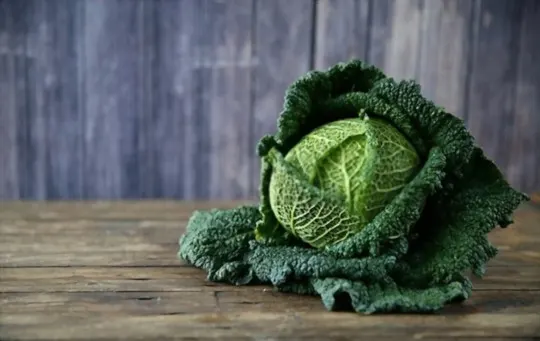Are you tired of eating the same cabbage every week?
Wondering what’s the difference between savoy and green cabbage? Look no further.
In this article, you’ll learn all about the different flavors, textures and uses for each type of cabbage.
So, let’s dive in and explore the differences between savoy and green cabbages.

What is Savoy Cabbage?

Savoy cabbage is a type of cabbage that is characterized by its crinkled and dark green leaves.
It belongs to the Brassica family along with other vegetables such as broccoli, cauliflower, and Brussels sprouts.
It is popular in many different cuisines around the world for its mild and sweet flavor.
One of the main differences between Savoy cabbage and other types of cabbage is its appearance.
While most types of cabbage have smooth leaves with a rounded shape, Savoy cabbage has crinkled leaves that are tightly packed together.
This gives it a distinct texture and appearance.
Another difference is the flavor profile.
While some varieties of cabbage can be quite strong and bitter, Savoy cabbage has a milder flavor that is slightly sweet.
This makes it a great choice for those who want to incorporate more cruciferous vegetables into their diet but don’t like the taste of traditional cabbage.
Savoy cabbage also has numerous health benefits due to its high nutritional value.
It is an excellent source of vitamin C, fiber, potassium, and vitamin K.
These nutrients can help improve digestion, boost immunity, lower blood pressure, and support bone health.
What is Green Cabbage?

Green cabbage is a nutritious and versatile vegetable that can contribute to a wide variety of meals.
This member of the Brassica family is known for its tight, round head and bright green color, which comes from its high chlorophyll content.
Green cabbage is denser and more flavorful than its red counterpart, and it pairs well with many different herbs and spices.
In addition to being delicious, green cabbage is also incredibly healthy – it’s packed with Vitamin C, fiber, and other essential nutrients that can help bolster your immune system and regulate digestion.
Whether you’re stir-frying it with garlic and sesame oil or using it as a main ingredient in a classic coleslaw, green cabbage is a must-have ingredient for any home cook looking to add variety and nutrition to their diet.
Differences Between Savoy Cabbage and Green Cabbage

When it comes to cabbage varieties, the two most commonly used are green cabbage and savoy cabbage.
While both belong to the Brassica oleracea species, they have some notable differences in terms of taste, texture, and appearance.
As you can see from the table above, savoy cabbage differs from green cabbage in several ways.
First off is their appearance – savoy has darker leaves compared to the light or dark green of green cabbage.
In terms of texture, savoy is less firm than the crunchy green cabbage and has a more delicate texture.
Moreover, when it comes to taste profile, savoy cabbages are sweeter in flavor compared to their slightly bitter counterparts – green cabbages – making them perfect for stuffing or using as wraps instead of being used in slaws or stir-fries like their counterparts.
In summary, if you’re looking for crunchier and slightly bitter-tasting greens that give your salads an extra bite then go with Green cabbages; on the other side if you prefer softer-texture vegetables with slight sweetness then choose Savoy cabbages for all your fresh vegetable needs.
Appearance and Texture
Savoy cabbage and green cabbage are two varieties of cabbage that are commonly used in many dishes.
When it comes to appearance and texture, there are distinct differences between them.
Savoy cabbage has crinkly leaves that are darker in color compared to green cabbage.
The leaves of savoy cabbage also tend to have more texture to them, which can be described as being soft and tender.
On the other hand, green cabbage has smooth leaves with a lighter or darker shade of green color.
The texture of green cabbage is more crunchy and firm than savoy cabbage.
In terms of taste, savoy cabbage has a delicate flavor that is not too overpowering.
Its softer texture makes it an excellent addition to soups, stews, stir-fries, or any dish where you want its mild flavor to come through.
Green cabbage, on the other hand, has a slightly bitter taste which adds depth to salads or coleslaw.
Taste and Flavor
When it comes to taste and flavor, Savoy cabbage and green cabbage differ distinctly.
The two varieties have varying levels of sweetness, earthiness, and bitterness.
Both Savoy cabbage and green cabbage have their unique flavors that can add depth to various dishes.
Savoy cabbage teaches your palate what true versatility is with its high level of natural sweetness that blends so perfectly with its faintly bitter undertones while providing an umami flavor when cooked.
Green cabbage is a milder cousin with less inherent sweetness but makes up for it in its complementing bitterness flavors perfect for matching other food flavors.
Nutritional Value

When it comes to comparing savoy cabbage vs green cabbage, we cannot overlook their nutritional value.
Both cabbages are rich in nutrients and minerals essential for the human body.
However, there are slight differences between the two varieties in terms of their nutritional content.
Both types of cabbage are low in calories and carbs while containing high levels of fiber and protein needed for muscle growth and repair in our bodies.
Savoy cabbage contains more Vitamin C than green cabbage, which is necessary for collagen production that aids wounds healing and helps to resist infections in our body.
Apart from that, savoy cabbage also contains relatively more vitamin E than green cabbage, which acts as an antioxidant protecting cells from damage caused by free radicals and reducing inflammation levels.
Green cabbage contains phytonutrients like sulforaphane that support liver health and has a high amount of folate necessary in fetal development during pregnancy.
Cooking Uses and Preparations
When it comes to cooking, both savoy cabbage and green cabbage are versatile ingredients that can be used in a variety of ways.
Savoy cabbage has a slightly sweeter taste than green cabbage which makes it particularly suited to raw preparations such as salads or coleslaw.
Its low calorie count also makes it perfect for diet-conscious meals.
Cooking Savoy cabbage involves steaming, stir-frying, sautéing or roasting it which adds depth of flavor while retaining its crispy texture.
Green cabbage is more commonly used in western cuisine as it is one of the most easily found types of cabbages worldwide.
Due to its hardness and thickness it is ideal boiled or steamed gently.
It makes an excellent base for soups where it can hold up after long periods without wilting completely.
Both cabbages can be pickled into sauerkraut but savoy’s looser leaves make them more suitable for fermentation as compared to the thick leaves of an ordinary cabbage.
Cabbage leaves are also great for wrapping food such as meat or vegetables, which makes them perfect for dishes like stuffed cabbage rolls.
Green cabbages are better because they have large, uniform leaves which make shaping for easier.
In contrast, savoy’s looser structure means that it is more ideal for recipes where the wrapper will be tied.
Where to Buy Savoy Cabbage and Green Cabbage and How to Store Them?

You can find both types of cabbage in most grocery stores, farmer’s markets, and even some community supported agriculture programs.
They are commonly found in the produce section, alongside other leafy vegetables.
When buying savoy cabbage or green cabbage, make sure they are fresh and do not have any browning or wilting leaves.
To store savoy cabbage and green cabbage, place them in a plastic bag or container with a lid in the vegetable crisper of your refrigerator.
Keep them away from fruits that produce ethylene gas as this can cause them to ripen too quickly.
Ideally, they should be stored below 40°F (4°C) and away from moisture for optimal freshness.
Stored properly, they can last up to two weeks.
If planning on using cabbage in a recipe that calls for steaming or boiling it (such as stuffed cabbage rolls), consider blanching the cabbage leaves first to soften and make them easier to handle.
Blanching involves briefly boiling the leaves before rinsing them under cold water to stop the cooking process.
Savoy cabbage is known for its crinkly loose-leaf texture and mild flavor while green cabbage has tightly packed layers of leaves with a slightly bitter taste.
Both cabbages are rich sources of nutrients such as vitamin C, fiber, and antioxidants making them great additions to any dish.
Whether you choose savoy or green cabbage, preparing these leafy vegetables doesn’t have to be complicated.
Simply slice, shred or chop them into your desired size for salads, stir-fries, stews or sautéed dishes.
The possibilities are endless.
Conclusion
As you can see from the comparison above, there are some noticeable differences between savoy cabbage and green cabbage.
Ultimately the choice between the two comes down to personal preference and how you plan to use them in your cooking.
Whether you pick one over the other or use them interchangeably is up to you.

Savoy Cabbage vs Green Cabbage: What’s the Difference?
Ingredients
- Savoy Cabbage
- Green Cabbage
Instructions
- Choose between two items based on your preference and availability.
- Follow the cooking directions for your chosen option, using the appropriate ratio of ingredients.
- Prepare it according to your desired recipes.
- Incorporate them into your dish, adjusting the amount to suit your taste.
- Enjoy the unique taste experience and experiment with different dishes to explore their versatility.

Andrew Gray is a seasoned food writer and blogger with a wealth of experience in the restaurant and catering industries. With a passion for all things delicious, Andrew has honed his culinary expertise through his work as a personal chef and caterer.
His love for food led him to venture into food writing, where he has contributed to various online publications, sharing his knowledge and insights on the culinary world. As the proud owner of AmericasRestaurant.com, Andrew covers a wide range of topics, including recipes, restaurant reviews, product recommendations, and culinary tips.
Through his website, he aims to inspire and educate fellow food enthusiasts, offering a comprehensive resource for all things food-related.

Leave a comment